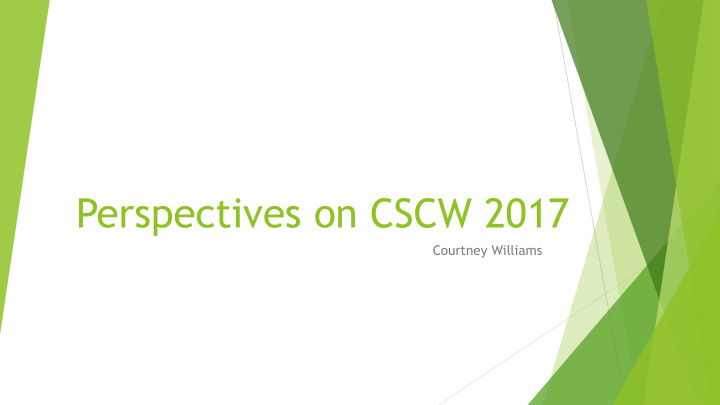



Perspectives on CSCW 2017 Courtney Williams
Opening Keynote – Conversational Intelligence: Bots and Lessons Learned Lili Cheng (Microsoft Research) Xiaoice (China), Tay (US) Advanced conversational bots Bots for work, bots for fun? (Age predictor, pictures of doggos) Interesting problems for research: Culture differences in the use of bots Gender perception – bots as females? Do people need to know when a bot is part of the conversation? Does that make them act differently?
Supporting Close Interpersonal Relationships Demanding by Design: Supporting Effortful Communication Practices in Close Personal Relationships University of Bath & Open University Important: Perceived effort (in a meaningful way) Interesting design challenge: How to integrate transparent, meaningful effort in communication technology But don’t just make the technology purposefully difficult to use Possible solutions: Snapchat, but with shaking? Perspective: Design communication technology that is meaningful for certain subsets of the population? http://dl.acm.org/citation.cfm?id=2998184&CFID=908869102&CFTOKEN=72327188
Supporting Close Interpersonal Relationships In Your Eyes: Anytime, Anywhere Video and Audio Streaming for Couples Simon Fraser University What is the effect of this technology for long-distance couples? Pros: Sense of closeness, share new experiences together Cons: Loss of privacy and independence, subjects broke up? Perspective: What if the technology worked in the opposite direction? http://dl.acm.org/citation.cfm?id=2998200&CFID=908869102&CFTOKEN=72327188
INQUIRE: Large-scale Early Insight Discovery for Qualitative Research UC Berkeley Uses natural language queries to search big data repositories of text for qualitative researchers LiveJournal – public personal diaries For early, exploratory phases Thoughts: Different data sources Demographics, inclusion/exclusion criteria Fake/exaggerated accounts? Ethics: Public, but not THAT public http://dl.acm.org/citation.cfm?id=2998363&CFID=908869102&CFTOKEN=72327188
Algorithmic Mediation in Group Decisions: Fairness Perceptions of Algorithmically Mediated vs. Discussion-Based Social Division Carnegie Mellon University, Google 2 scenarios – Preparing for a “house party”, choosing snacks Algorithmic decision, group decision Algorithms perceived as unfair Algorithms vulnerable to manipulation in inputs Groups can take into account personal limitations, “volunteering” for an unpleasant choice makes it fair How do we improve these algorithms to take this into account? Take- away: Provide justification for the algorithm’s decisions? http://dl.acm.org/citation.cfm?id=2998230&CFID=908869102&CFTOKEN=72327188
Empowering Investors with Social Annotation When Saving for Retirement New York University, RAND Corporation Saving for retirement is difficult when financial documents that inform investment decisions are too complicated to decipher Solution: Social Annotation? – comments from MTurk users on the side Virtual investment game – Better performance in novices with commentary, little difference in experts Perception: Vulnerable to trolling? Only expert commentary wanted? If viable…. Applicable for maintaining health? http://dl.acm.org/citation.cfm?id=2998253&CFID=908869102&CFTOKEN=72327188
Anyone Can Become a Troll: Causes of trolling Behavior in Online Discussions Stanford University, Cornell University Best Paper award winner Definition: Behavior that falls outside acceptable bounds defined by a discussion community Experiment: Political Articles about DNC, analysis of CNN comments Factors: Mood (frustrating situations), Context (are others trolling?) Past trolling: Strong indicator of future trolling Future research: Out-of-control cycle (neg. context -> negative mood -> trolling -> negative context...) How to combat trolling in “normal” people? http://dl.acm.org/citation.cfm?id=2998213&CFID=908869102&CFTOKEN=72327188
Supporting Patient-Provider Collaboration to Identify Individual Triggers using Food and Symptom Journals University of Washington IBS patients track their diet, this data used to produce visualizations for nutrient intake vs symptom severity Bar charts, parallel coordinates Results: Physicians split over patients having access Scared of appearing incompetent in front of patient Excellent resource Perspective: Useful for treating many illnesses ( Chron’s /Collitis) Pre-emptive measure: Useful for diagnosis? http://dl.acm.org/citation.cfm?id=2998276&CFID=908869102&CFTOKEN=72327188
“I’m so glad I met you”: Designing dynamic collaborative support for young adult cancer survivors University of Washington Young adult needs during “6 phases of survivorship” How they used technology to support these needs Design future software tools to address these needs more effectively Plot hole: All participants were in the final stage at the time Remember their needs in earlier stages differently, different perspective How to gain access to participants in other stages Interview participants over their journey, how this evolves over time http://dl.acm.org/citation.cfm?id=2998276&CFID=908869102&CFTOKEN=72327188
Closing Keynote – The Science Gap Jorge Cham, PhD Comics PhD Comics as a tool for community – We’re not alone! Research -> Society SCIENTIST used COMMUNICATE It’s not very effective…. Bypass the process: Animation Videos go viral – reach the broader audience Take- away: Get better at communicating… Show the value in our work!
Recommend
More recommend